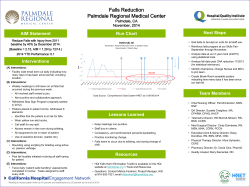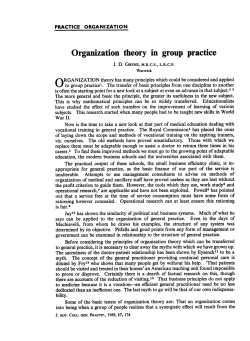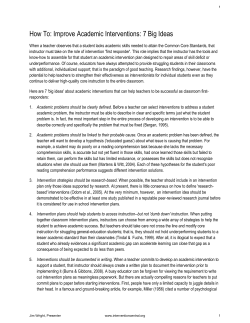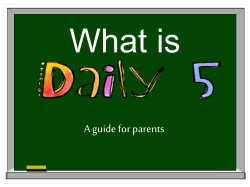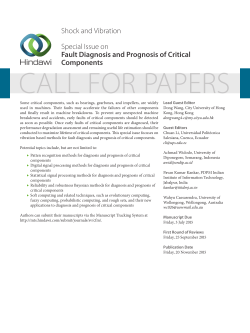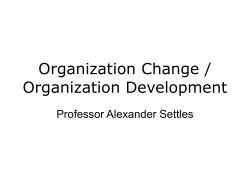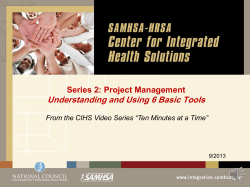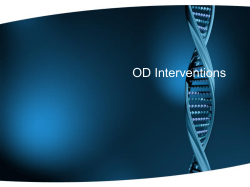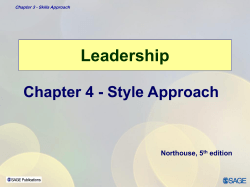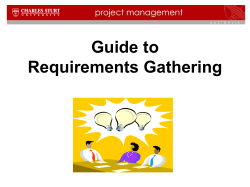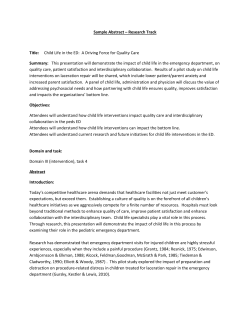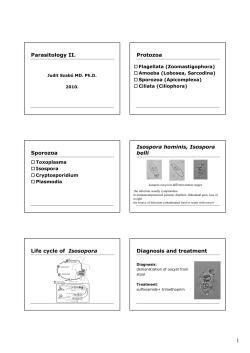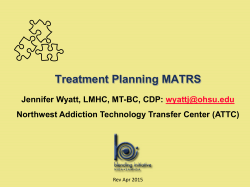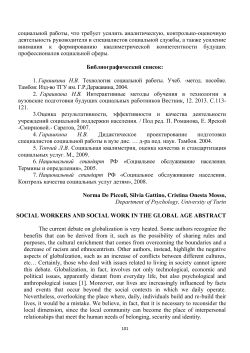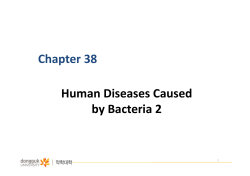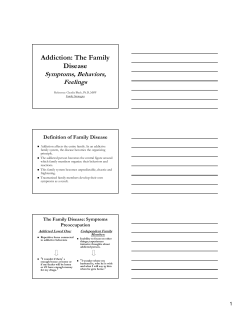
The Nature of Planned Change HRDMAN6
The Nature of Planned Change HRDMAN6 O The pace of global, economic, and technological development makes change an inevitable feature of organizational life. However, change that happens to an organization can be distinguished from change that is planned by its members. O OD is directed at bringing about planned change to increase an organization’s effectiveness and capability to change itself. Theories of Planned Change HRDMAN6 Lewin’s Change Model O Lewin conceived of change as modification of those forces keeping a system’s behavior stable. Specifically, a particular set of behaviors at any moment in time is the result of 2 groups of forces: those striving to maintain status quo and those pushing for change. O Lewin viewed this change process as consisting of the following three steps: O Unfreezing – involves reducing those forces maintaining the organization’s behavior at its present level. This is sometimes accomplished through a process of “psychological disconfirmation.” By introducing information that shows discrepancies between behaviors desired by organization members and those behaviors currently exhibited, members can be motivated to engage in change activities. O Moving / Changing– this shifts the behavior of the organization, department, or individual to a new level. It involves intervening in the system to develop new behaviors, values, and attitudes through changes in organizational structures and processes. O Refreezing – stabilizes the organization at a new state of equilibrium. It is frequently accomplished through the use of supporting mechanisms that reinforce the new organizational state, such as organizational culture, rewards, and structures. Action Research Model O This focuses on planned change as a cyclical process in which initial research about the organization provides information to guide subsequent action. Then the results of the action are assessed to provide further information to guide further action, and so on. 8 steps: O Problem Identification O Consultation w/ a Behavioral Science Expert O Data Gathering and Preliminary Diagnosis O Feedback to a Key Client or Group O Joint Diagnosis of the Problem O Joint Action Planning O Action O Data Gathering After Action Positive Model O This focuses on what the organization is doing right. It helps members understand their organization when it is working at its best and builds off those capabilities to achieve even better results. 5 Phases: O Initiate the Inquiry O Inquire into Best Practices O Discover the Themes O Envision a Preferred Future O Design and Deliver Ways to Create the Future General Model of Planned Change HRDMAN6 Entering and Contracting Diagnosing Planning and Implementing Change Evaluating and Institutionalizing Change The arrows connecting the different activities in the model show the typical sequence of events, from entering and contracting, to diagnosing, to planning and implementing change, to evaluating and institutionalizing change. The lines connecting the activities emphasize that organizational change is not a straightforward, linear process but involves considerable overlap and feedback among the activities. Entering and Contracting O Entering an organization involves gathering initial data to understand the problems facing the organization or to determine the positive areas for inquiry. After information is collected, the problems or opportunities are discussed with managers and other organization members to develop a contract or agreement to engage in planned change. The contract spells out future change activities, the resources to be committed, and how OD practitioners and organization members will be involved. Diagnosing O In this stage, the client system is carefully studied. Diagnosis can focus on understanding organizational problems, including their causes and consequences, or on collecting stories about the organization’s positive attributes. The diagnostic process is one of the most important activities in OD. It includes choosing an appropriate model for understanding the organization and gathering, analyzing, and feeding back information to managers and organization members about the problems or opportunities that exist. Planning and Implementing Change O Interventions are designed to achieve the organization’s vision or goals and make action plans to implement them. O Four major types of interventions: O Human process interventions at the individual, group, and total system levels O Interventions that modify an organization’s structure and technology O Human resources interventions that seek to improve member performance and wellness O Strategic interventions that involve managing the organization’s relationship to its external environment and the internal structure and process necessary to support a business strategy Evaluating and Institutionalizing Change O This involves evaluating the effects of the intervention and managing the institutionalization of successful change programs so they persist. Feedback to organization members about the intervention’s results provides information about whether the changes should be continued, modified, or suspended. Institutionalizing successful changes involves reinforcing them through feedback, rewards, and, training. Different Types of Planned Change Key Dimensions Magnitude of Change Degree of Organization Domestic vs. International Settings Magnitude of Change O Planned change efforts can be characterized as falling along a continuum ranging from incremental changes that involve fine-tuning the organization to fundamental changes that entail radically altering how it operates. O Incremental changes tend to involve limited dimensions and levels of the organization, such as the decision-making processes of work groups. They occur within the context of the organization’s existing business strategy, structure, and culture and are aimed at improving the status quo. O Fundamental changes, on the other hand, are directed at significantly altering how the organization operates. They tend to involve several organizational dimensions, including structure, culture, reward systems, information processes, and work design. They also involve changing multiple levels of the organization, from top-level management through departments and work groups to individual jobs. Degree of Organization O Planned change efforts also can vary depending on the degree to which the organization or client system is organized. O In over-organized situations, such as in highly mechanistic, bureaucratic organizations, various dimension such as leadership styles, job designs, organization structure, and policies and procedures are too rigid and overly defined for effective task performance. Communication between management and employees is typically suppressed, conflicts are avoided, and employees are apathetic. O In under-organized organizations, there is too little constraint or regulation for effective task performance. Leadership, structure, job design, and policy are poorly defined and fail to direct task behaviors effectively. Communication is fragmented, job responsibilities are ambiguous, and employees’ energies are dissipated because they lack direction. O Typically found in areas like product development, project management, and community development, where relationships among diverse groups and participants must be coordinated around complex, uncertain tasks. O In over-organized situations, planned change is generally aimed at loosening constraints on behavior. O Changes in leadership, job design, structure, and other features are designed to liberate suppressed energy, to increase the flow of relevant information between employees and managers, and to promote effective conflict resolution. O Typical steps: entry, diagnosis, intervention, and evaluation – intended to penetrate a relatively closed organization or department and make it increasingly open to self-diagnosis and revitalization. O In under-organized organization, planned change is aimed at increasing organization by clarifying leadership roles, structuring, communication between managers and employees, and specifying job and departmental responsibilities. O Typical steps: O Identification O Convention O Organization O Evaluation Domestic vs International Settings O Planned change efforts have traditionally been applied in north American and European settings, but they are increasingly used outside of these cultures. O Cultural differences can make OD more difficult to implement. O An OD process that encourages openness among individuals, high levels of participation, and actions that promote increased effectiveness is viewed favorably. Critique of Planned Change Conceptualization of Planned Change O Planned change, according to Porras and Robertson should be guided by information about: O Organizational features that can be changed O Intended outcomes from making those changes O Causal mechanisms by which those out comes are achieved O Contingencies upon which successful change depends O A related area where current thinking about planned change is deficient is knowledge about how the stages of planned change differ across situations. O It tends to be described as a rationally controlled, orderly process – a view that may be comforting but seriously misleading. O The relationship between planned change and organizational performance and effectiveness is not well understood. Practice of Planned Change O Effective change depends on a careful diagnosis of how the organization is functioning. Diagnosis identifies the underlying cases of organizational problems or determines the positive opportunities that need to be promoted. It requires time and money, and some organizations are not willing to make the necessary investment. O It is a long-term process involving considerable innovation and learning on-site. It requires a good deal of time and commitment and a willingness to modify and refine changes as the circumstances require. O Changing any one part or feature of an organization often requires adjustments in the other parts to maintain an appropriate alignment. Thus, quick fixes are discouraged.
© Copyright 2025

